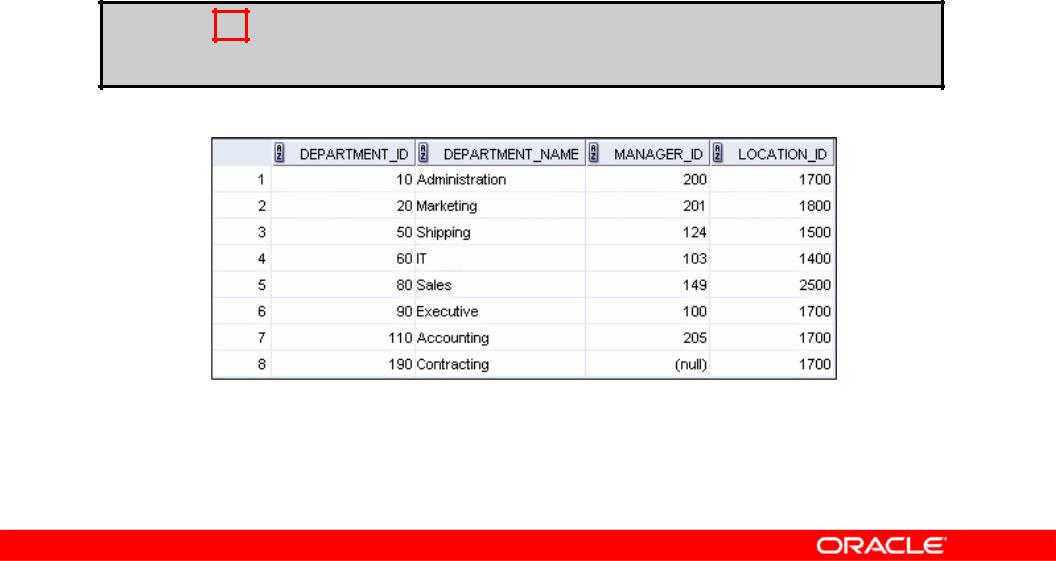
Les02
.pdf
Retrieving Data Using
the SQL SELECT Statement
Copyright © 2009, Oracle. All rights reserved.

Objectives
After completing this lesson, you should be able to do the following:
•List the capabilities of SQL SELECT statements
•Execute a basic SELECT statement
1 - 2 |
Copyright © 2009, Oracle. All rights reserved. |

Lesson Agenda
•Basic SELECT statement
•Arithmetic expressions and NULL values in the SELECT statement
•Column aliases
•Use of concatenation operator, literal character strings, alternative quote operator, and the DISTINCT keyword
•DESCRIBE command
1 - 3 |
Copyright © 2009, Oracle. All rights reserved. |

Capabilities of SQL SELECT Statements
Projection |
Selection |
||||||||||
|
|
|
|
|
|
|
|
|
|
|
|
|
|
|
|
|
|
|
|
|
|
|
|
|
|
|
|
|
|
|
|
|
|
|
|
|
|
|
|
|
|
|
|
|
|
|
|
|
|
|
|
|
|
|
|
|
|
|
|
|
|
|
|
|
|
|
|
|
|
|
|
|
|
|
|
|
|
|
|
|
|
|
|
|
|
|
|
|
|
|
|
|
|
|
|
|
|
|
|
|
|
|
|
|
|
|
|
|
|
|
|
|
|
|
|
|
|
|
|
|
|
|
|
|
|
|
|
|
|
|
|
|
|
|
|
|
|
|
|
|
|
|
|
|
|
|
|
|
|
|
|
|
|
|
|
Table 1 |
Table 1 |
Join
Table 1 |
Table 2 |
1 - 4 |
Copyright © 2009, Oracle. All rights reserved. |

Basic SELECT Statement
SELECT *|{[DISTINCT] column|expression [alias],...} FROM table;
•SELECT identifies the columns to be displayed.
•FROM identifies the table containing those columns.
1 - 5 |
Copyright © 2009, Oracle. All rights reserved. |

Selecting All Columns
SELECT *
FROM departments;
1 - 6 |
Copyright © 2009, Oracle. All rights reserved. |

Selecting Specific Columns
SELECT department_id, location_id
FROM departments;
1 - 7 |
Copyright © 2009, Oracle. All rights reserved. |

Writing SQL Statements
•SQL statements are not case-sensitive.
•SQL statements can be entered on one or more lines.
•Keywords cannot be abbreviated or split across lines.
•Clauses are usually placed on separate lines.
•Indents are used to enhance readability.
•In SQL Developer, SQL statements can optionally be terminated by a semicolon (;). Semicolons are required when you execute multiple SQL statements.
•In SQL*Plus, you are required to end each SQL statement with a semicolon (;).
1 - 8 |
Copyright © 2009, Oracle. All rights reserved. |

Column Heading Defaults
•SQL Developer:
–Default heading alignment: Left-aligned
–Default heading display: Uppercase
•SQL*Plus:
–Character and Date column headings are left-aligned.
–Number column headings are right-aligned.
–Default heading display: Uppercase
1 - 9 |
Copyright © 2009, Oracle. All rights reserved. |

Lesson Agenda
•Basic SELECT statement
•Arithmetic expressions and NULL values in the SELECT statement
•Column Aliases
•Use of concatenation operator, literal character strings, alternative quote operator, and the DISTINCT keyword
•DESCRIBE command
1 - 10 |
Copyright © 2009, Oracle. All rights reserved. |
